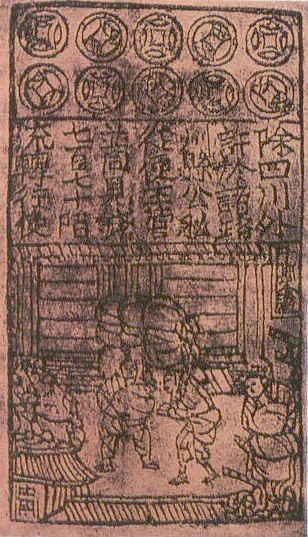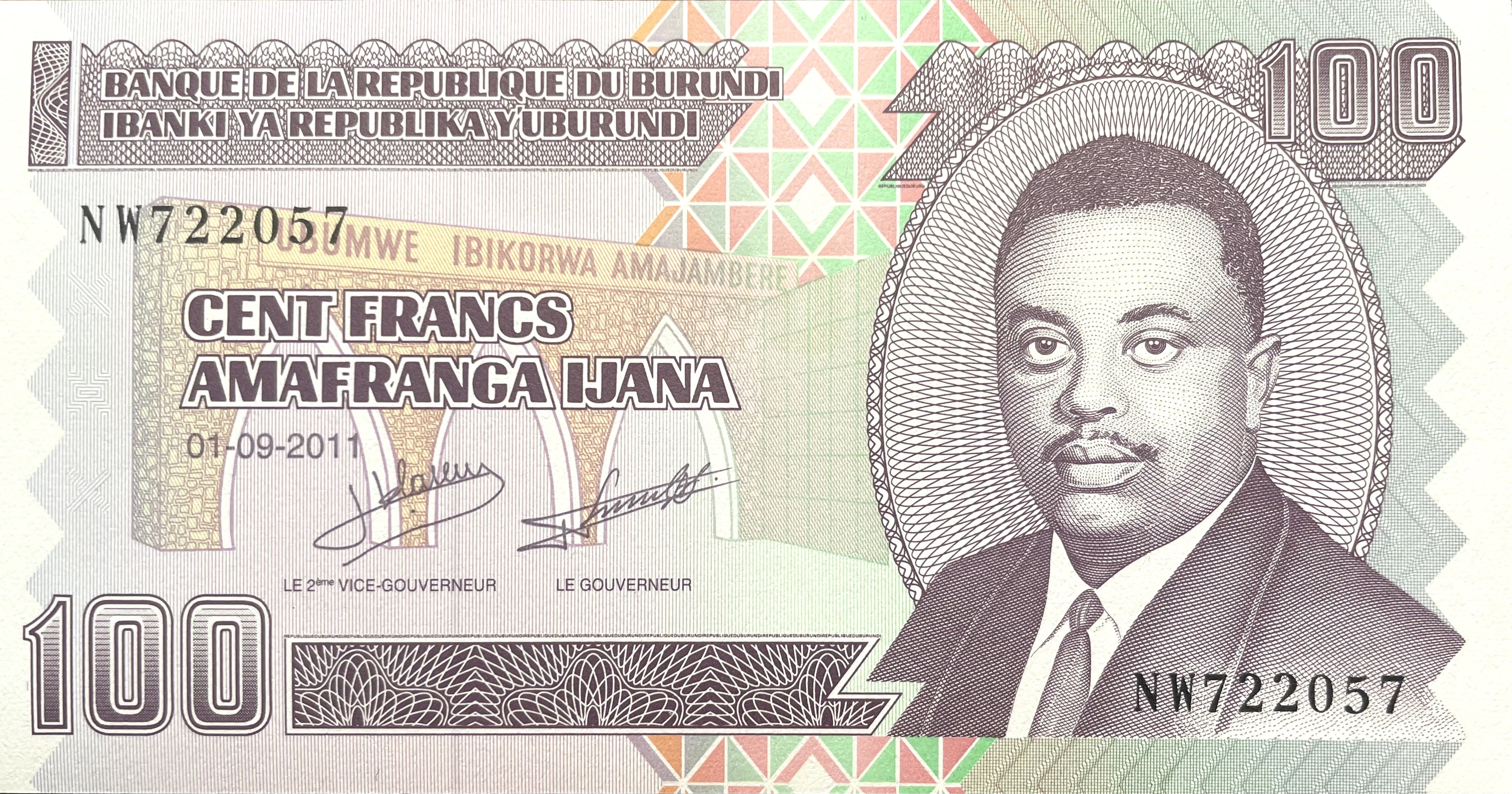|
Rwandese Franc
The Rwandan francNational Bank of Rwanda.Legal tender." Accessed 2011-02-25. (sign: FRw,National Bank of Rwanda.Currency characteristics" Accessed 2017-02-20. and possibly RF or R₣; ISO 4217: RWF) is the currency of Rwanda. History The franc became the currency of Rwanda in 1916, when Belgium occupied the previously German colony and the Belgian Congo franc replaced the German East African rupie. Rwanda used the currency of the Belgian Congo until 1960, when the Rwanda and Burundi franc was introduced. Rwanda began issuing its own francs in 1964, two years after gaining independence. A proposal exists to introduce a common currency, a new East African shilling, for the five member states of the East African Community. Whilst originally scheduled to occur by the end of 2012, as of March 2025, a common currency has still yet to be introduced. Coins In 1964, coins were introduced for 1, 5 and 10 francs, with the 1 and 10 francs in cupronickel and the 5 francs in bronze. In 1969 ... [...More Info...] [...Related Items...] OR: [Wikipedia] [Google] [Baidu] |
Centime
Centime (from ) is French language, French for "Cent (currency), cent", and is used in English as the name of the fraction currency in several Francophone countries (including Switzerland, Algeria, Belgium, Morocco and France). In France, the usage of ''centime'' goes back to the introduction of the decimal currency, decimal monetary system under Napoleon. This system aimed at replacing non-decimal fractions of older coins. A five-centime coin was known as a ''sou'', i.e. a Solidus (coin), solidus or shilling. In Francophone Canada of a Canadian dollar is officially known as a ''cent'' (pronounced /sɛnt/) in both English and French. However, in practice, the form of ''cenne'' (pronounced /sɛn/) has completely replaced the official ''cent''. Spoken and written use of the official form ''cent'' in Francophone Canada is exceptionally uncommon. In the Canadian French vernacular ''sou'', ''sou noir'' ( means "black" in French), ''cenne'', and ''cenne noire'' are all widely known ... [...More Info...] [...Related Items...] OR: [Wikipedia] [Google] [Baidu] |
Cupronickel
Cupronickel or copper–nickel (CuNi) is an alloy of copper with nickel, usually along with small quantities of other metals added for strength, such as iron and manganese. The copper content typically varies from 60 to 90 percent. ( Monel is a nickel–copper alloy that contains a minimum of 52 percent nickel.) Despite its high copper content, cupronickel is silver in colour. Cupronickel is highly resistant to corrosion by salt water, and is therefore used for piping, heat exchangers and condensers in seawater systems, as well as for marine hardware. It is sometimes used for the propellers, propeller shafts, and hulls of high-quality boats. Other uses include military equipment and chemical industry, petrochemical industry, and electrical industries. In decorative use, a cupronickel alloy called nickel silver is common, although it contains additional zinc but no silver. Another common 20th-century use of cupronickel was silver-coloured coins. For this use, the typical alloy ... [...More Info...] [...Related Items...] OR: [Wikipedia] [Google] [Baidu] |
Currencies Of Rwanda
A currency is a standardization of money in any form, in use or circulation as a medium of exchange, for example banknotes and coins. A more general definition is that a currency is a ''system of money'' in common use within a specific environment over time, especially for people in a nation state. Under this definition, the British Pound sterling (£), euros (€), Japanese yen (¥), and U.S. dollars (US$) are examples of (government-issued) fiat currencies. Currencies may act as stores of value and be traded between nations in foreign exchange markets, which determine the relative values of the different currencies. Currencies in this sense are either chosen by users or decreed by governments, and each type has limited boundaries of acceptance; i.e., legal tender laws may require a particular unit of account for payments to government agencies. Other definitions of the term ''currency'' appear in the respective synonymous articles: banknote, coin, and money. This article uses ... [...More Info...] [...Related Items...] OR: [Wikipedia] [Google] [Baidu] |
Burundian Franc
The franc (ISO 4217 code is BIF) is the currency of Burundi. It is nominally subdivided into 100 ''centimes'', although coins have never been issued in centimes since Burundi began issuing its own currency. Only during the period when Burundi used the Belgian Congo franc were centime coins issued. History The franc became the currency of Burundi in 1916, when Belgium occupied the former German colony and replaced the German East African rupie with the Belgian Congo franc. Burundi used the currency of Belgian Congo until 1960, when the Rwanda and Burundi franc was introduced. Burundi began issuing its own francs in 1964. There were plans to introduce a common currency, a new East African shilling, for the five member states of the East African Community by the end of 2015. , these plans have not yet materialized. Coins In 1965, the ''Bank of the Kingdom of Burundi'' issued brass Brass is an alloy of copper and zinc, in proportions which can be varied to achieve differen ... [...More Info...] [...Related Items...] OR: [Wikipedia] [Google] [Baidu] |
Economy Of Rwanda
The economy of Rwanda has undergone rapid industrialisation due to a successful governmental policy. It has a mixed economy. Since the early-2000s, Rwanda has witnessed an economic boom, which improved the living standards of many Rwandans. The President of Rwanda, Paul Kagame, has noted his ambition to make Rwanda the "Singapore of Africa". The industrial sector is growing, contributing 16% of GDP in 2012. History Before the civil war and genocide In the 1960s and 1970s, Rwanda's prudent financial policies, coupled with generous external aid and relatively favorable terms of trade, resulted in sustained growth in per capita income and low inflation rates. However, when world coffee prices fell sharply in the 1980s, growth became erratic. Compared to an annual GDP growth rate of 6.5% from 1973 to 1980, growth slowed to an average of 2.9% a year from 1980 through 1985 and was stagnant from 1986 to 1990. The crisis peaked in 1990 when the first measures of an IMF structural adju ... [...More Info...] [...Related Items...] OR: [Wikipedia] [Google] [Baidu] |
National Museum Of Rwanda
The Ethnographic Museum (), formerly the National Museum of Rwanda (, ), is a national museum in Rwanda. It is located in Butare. It is owned by Institute of National Museums of Rwanda. It was built with help of the Belgian government and opened in 1989. It is also a good source of information on the cultural history of the country and the region. It is also known as the site of the murder of Queen Dowager Rosalie Gicanda and several others during the Rwandan genocide.Rwanda genocide: Nizeyimana convicted of killing Queen Gicanda 19 June 2012, BBC, Retrieved 2 March 2016 References External links - [...More Info...] [...Related Items...] OR: [Wikipedia] [Google] [Baidu] |
Steel
Steel is an alloy of iron and carbon that demonstrates improved mechanical properties compared to the pure form of iron. Due to steel's high Young's modulus, elastic modulus, Yield (engineering), yield strength, Fracture, fracture strength and low raw material cost, steel is one of the most commonly manufactured materials in the world. Steel is used in structures (as concrete Rebar, reinforcing rods), in Bridge, bridges, infrastructure, Tool, tools, Ship, ships, Train, trains, Car, cars, Bicycle, bicycles, Machine, machines, Home appliance, electrical appliances, furniture, and Weapon, weapons. Iron is always the main element in steel, but other elements are used to produce various grades of steel demonstrating altered material, mechanical, and microstructural properties. Stainless steels, for example, typically contain 18% chromium and exhibit improved corrosion and Redox, oxidation resistance versus its carbon steel counterpart. Under atmospheric pressures, steels generally ... [...More Info...] [...Related Items...] OR: [Wikipedia] [Google] [Baidu] |
Plated
Plating is a finishing process in which a metal is deposited on a surface. Plating has been done for hundreds of years; it is also critical for modern technology. Plating is used to decorate objects, for corrosion inhibition, to improve solderability, to harden, to improve wearability, to reduce friction, to improve paint adhesion, to alter conductivity, to improve IR reflectivity, for radiation shielding, and for other purposes. Jewelry typically uses plating to give a silver or gold finish. Thin-film deposition has plated objects as small as an atom, therefore plating finds uses in nanotechnology. There are several plating methods, and many variations. In one method, a solid surface is covered with a metal sheet, and then heat and pressure are applied to fuse them (a version of this is Sheffield plate). Other plating techniques include electroplating, vapor deposition under vacuum and sputter deposition. Recently, plating often refers to using liquids. Metallizing refers to c ... [...More Info...] [...Related Items...] OR: [Wikipedia] [Google] [Baidu] |
Nickel
Nickel is a chemical element; it has symbol Ni and atomic number 28. It is a silvery-white lustrous metal with a slight golden tinge. Nickel is a hard and ductile transition metal. Pure nickel is chemically reactive, but large pieces are slow to react with air under standard conditions because a passivation layer of nickel oxide forms on the surface that prevents further corrosion. Even so, pure native nickel is found in Earth's crust only in tiny amounts, usually in ultramafic rocks, and in the interiors of larger nickel–iron meteorites that were not exposed to oxygen when outside Earth's atmosphere. Meteoric nickel is found in combination with iron, a reflection of the origin of those elements as major end products of supernova nucleosynthesis. An iron–nickel mixture is thought to compose Earth's outer and inner cores. Use of nickel (as natural meteoric nickel–iron alloy) has been traced as far back as 3500 BCE. Nickel was first isolated and classifie ... [...More Info...] [...Related Items...] OR: [Wikipedia] [Google] [Baidu] |
Magnesium
Magnesium is a chemical element; it has Symbol (chemistry), symbol Mg and atomic number 12. It is a shiny gray metal having a low density, low melting point and high chemical reactivity. Like the other alkaline earth metals (group 2 of the periodic table), it occurs naturally only in combination with other elements and almost always has an oxidation state of +2. It reacts readily with air to form a thin Passivation (chemistry), passivation coating of magnesium oxide that inhibits further corrosion of the metal. The free metal burns with a brilliant-white light. The metal is obtained mainly by electrolysis of magnesium Salt (chemistry), salts obtained from brine. It is less dense than aluminium and is used primarily as a component in strong and lightweight magnesium alloy, alloys that contain aluminium. In the cosmos, magnesium is produced in large, aging stars by the sequential addition of three Helium nucleus, helium nuclei to a carbon nucleus. When such stars explo ... [...More Info...] [...Related Items...] OR: [Wikipedia] [Google] [Baidu] |





